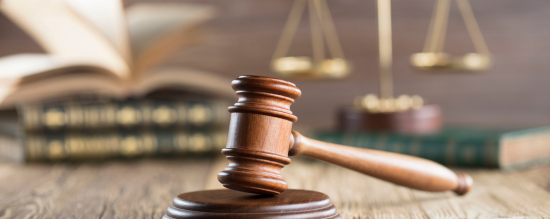Jason J. Joy News

A Houston-based law firm, Jason J. Joy & Associates, has issued an urgent warning regarding the rapidly closing window for filing AFFF/PFAS lawsuit claims. The firm estimates that individuals exposed to these harmful chemicals have only four to five weeks left to initiate new claims for compensation. This alert is primarily directed at firefighters, military personnel, and others who have been in contact with Aqueous Film-Forming Foam (AFFF).

Over two weeks ago, state regulators announced their plans to scrutinize homeowner insurer companies more closely. The objective was to glean comprehensive data about the firms' modus operandi (Mode of operating) in the homeowner insurance sector. However, there seems to be a hitch in the seemingly faultless plan as some critical states are now considering stepping back from this initiative, potentially throwing a spanner in the works. The idea behind this national plan was simple - to bring about transparency and promote equitable practices in the homeowner insurance industry. But the recent stance of key states opting out threatens to hamper the execution and effectiveness of the overall plan. This news has not only taken the industry by surprise but has also raised essential questions about the future of homeowners insurance in these particular areas. Is this decision a temporary hiccup, or does it signify a more significant shift in the regulatory landscape? Only time will tell how this situation evolves, the subsequent impact on homeowners, the insurance companies, and the overall health of the sector. Homeowners Insurance Regulations Despite the waves of change that have swept across the insurance industry over the years, homeowners' insurance has remained an essential part of every homeowner's journey. It forms a safety net that protects us from losses and damages that could happen to our homes, securing our investments and ensuring our peace of mind. The path to acquisition isn't exactly a walk in the park. Many homeowners face a series of state-specific hurdles that can make the process confusing and, at times, discouraging. The NAIC (National Association of Insurance Commissioners) has recognized these challenges, shedding light on the situation where insurers grapple with varying state regulations, divergent market conditions, and differing consumer expectations. This mix of factors has resulted in significant disparities in coverage, cost, and conditions across the country. If you're a homeowner, or planning to become one, understanding these hurdles can prepare you for what lies ahead. Let's delve into the complexities of homeowners' insurance and highlight some of the solutions proposed by NAIC to help homeowners and insurers alike. Understanding State-Specific Insurance Hurdles Insurers typically use a 'one-size-fits-all' model, but this does not apply well in the homeowners' insurance market. Why? Because each state presents unique conditions, challenges, and requirements that insurers must navigate. How Differing Market Conditions Impact Insurers The economic, environmental, and social conditions in each state create distinct market situations that insurers must grapple with. Ultimately, the NAIC's spotlight on these hurdles is a timely wake-up call. A more harmonized approach in regulating homeowners' insurance could be the key to ensuring a smoother path for future homeowners. By understanding these hurdles and exploring proposed solutions, homeowners can be better informed and prepared. Understanding Homeowners Insurance When you purchase a homeowners insurance policy, you’re not only safeguarding your home from unexpected damages, but you're also protecting your personal belongings and finances. The three main components of most homeowners insurance policies include: Property Coverage : This element protects your home and any other structures on your property from risks such as fire, theft, vandalism, or certain natural disasters. Liability Protection : In the event that someone is injured on your property, liability insurance covers their medical expenses or legal fees if they decide to take legal action. Additional Living Expenses (ALE) : Should you have to vacate your home for a period, ALE will cover the costs of staying elsewhere, along with additional living expenses like food or transportation. Factors that can affect the cost of your homeowners insurance premiums include the location of your home, its age, your claims history, the materials and systems of your home, as well as your credit score. Choosing the Right Policy for Your Home Selecting the best homeowners insurance policy requires a thoughtful and thorough approach. Here are the steps you should follow: Assess Your Needs : Consider the value of your home and belongings realistically, and imagine worst-case scenarios. Understand Deductibles and Limits : A higher deductible can lower your premiums, but make sure it’s an amount you can comfortably afford. Similarly, you don't want to under-insure your home and assets. Comparing Policies and Insurers : Gather quotes from different companies and compare them not only on cost but also on coverage details, claim processing, and customer service. The Claims Process When the unthinkable happens, it’s crucial to know how to protect your interests during the claims process for a smooth resolution: After Damage or Loss : Document the damage thoroughly, make any temporary repairs to prevent further damage, and keep records of expenses. Avoiding Common Mistakes : Don’t make the mistake of delaying to file a claim, throwing away damaged items, or overlooking the fine print of your policy. Ensuring a Fair Settlement : Be assertive and prepared when discussing your claim, and consider hiring a public adjuster if you encounter disputes with your insurance company. Insurance Disputes When facing disputes with your insurance company over a claim, it's essential to understand the complexities involved in the insurance process and the legal nuances that can determine the outcome of your claim. Many homeowners find themselves at a disadvantage when navigating these disputes, as insurance companies have extensive resources and legal expertise at their disposal. In such cases, having an experienced attorney can make a significant difference. Insurance disputes can be daunting and highly complex which is why knowing your rights is critical. If you or someone you know is struggling with a dispute against their insurance company our office encourages you to reach out to us today for a free consultation with one of our legal experts. Conclusion Homeowners insurance is the bedrock of peace of mind when it comes to the safety and security of your home and family. By understanding how this form of insurance works, you can approach it as both a protective measure and an integral part of your financial well-being.

Disclaimer: The information provided in this article is accurate as of its publication date. Given the dynamic nature of legal proceedings and FDA findings, the current status may have changed. Readers are urged to consult the most recent sources for the latest information before drawing conclusions or making decisions based on this article. Breast cancer patients and the bustling medical device industry were met with an unexpected turn of events when the Food and Drug Administration (FDA) recently issued a safety communication about BioZorb, a product designed to improve breast cancer treatment. The unique marker has been touted as a revolutionary tool for both patients and doctors. However, the new warnings raise critical concerns that the community cannot afford to overlook. This blog post dives deep into the FDA's message, explores the technology behind BioZorb, and uncovers what this means for the future of breast cancer treatment. A Closer Look at BioZorb Promise Developed to aid in the visualization and targeting of the tumor bed in patients with breast cancer, BioZorb is a 3D marker that improves the accuracy of radiation treatment, keeps the breast's natural shape, and promotes tissue repair. Surgeons implant the marker directly into the breast, where it acts as a guidepost for both clinicians and patients. This innovation sparked hope within the medical community upon its introduction, as it appeared to offer both a technical edge for practitioners and a comfort for those experiencing the traumatic process of cancer treatment. The BioZorb Marker and BioZorb LP Marker have two components: a resorbable plastic component that is intended to be resorbed completely by the patient's body in one year or longer, and a titanium metal component that is permanent. The FDA's Disquieting Notice The FDA's recent safety communication highlighted several distressing observations regarding the use of BioZorb in breast tissue. The alert was issued after numerous patient reports and medical studies detailed instances of complications such as pain, infection, and migration of the device. Additionally, concerns were raised about the need for repeat procedures due to BioZorb-related issues. The thorough analysis by the FDA extended to questions about the long-term safety and effectiveness of the product, prompting a reevaluation of its use in clinical settings. Potential Risks Associated with the Use of BioZorb Marker and BioZorb LP Marker devices in Breast Tissue The device moving out of position (migration) and breaking through the chest cavity and/or blood vessels can have severe, life-threatening consequences. It may also affect future radiation targeting at the intended site. The concerns highlighted by the FDA's safety communication regarding the BioZorb and BioZorb LP Marker devices can be categorized into a few critical risk areas. Pain and discomfort have been reported by numerous patients, varying from mild to severe, and may persist longer than initially anticipated. The risk of infection is another significant concern, with the implanted device potentially acting as a nidus for bacterial growth, leading to serious health complications if not promptly addressed. The necessity for repeat procedures due to issues directly related to the BioZorb device poses not only a health risk to patients but also increases the psychological and financial burden on them. These potential risks underline the importance of a careful and informed approach to the use of BioZorb and BioZorb LP Marker devices in breast tissue treatment, emphasizing patient safety and well-being above all. Patient and Provider Protocols in the Wake of Warnings The issuance of FDA warnings necessitates immediate action. Patients who currently have BioZorb in place are advised to remain vigilant for any signs of complications, consult their healthcare providers, and consider alternative treatments. Meanwhile, healthcare professionals are urged to thoroughly discuss the risks associated with BioZorb and explore alternative therapeutic strategies. Both parties are encouraged to maintain open communication and ensure that patient safety is of the highest priority. FDA Actions The FDA is collaborating with Hologic Inc. to comprehensively assess the safety of BioZorb Marker and BioZorb LP Marker devices in breast tissue and address potential risks associated with their use. Continual monitoring of adverse events by the FDA will ensure prompt updates to the public should significant new information arise. In Conclusion: A Shared Journey Toward Safer Solutions The FDA's announcement regarding BioZorb is a signal for all involved in the breast cancer community to take stock and redouble efforts towards patient safety and informed treatment options. By heeding the warnings and engaging in an open exchange of insights and challenges, we can collectively drive the evolution of medical devices toward greater effectiveness and reliability. Breast cancer patients and survivors are at the center of this pivotal moment, empowered to share their stories and advocate for treatments that honor their voices and experiences. The road to a safer tomorrow is shared, and the strides we take today will define the standards we set for the innovations that hold the promise of a healthier, brighter future. If you or someone you know has been negatively affected by any of the symptoms/effects mentioned above via BioZorb device, knowing your legal rights is imperative. Reach out to us at Jason Joy & Associates for a free legal consultation today. It's vital that victims understand the potential for recourse and the importance of advocating for their health and wellbeing. Legal professionals specializing in medical device litigation can provide essential insights and guidance, ensuring that patients receive the support and compensation they deserve. Disclaimer: The information provided in this document, including but not limited to, discussions related to health, treatments, and devices such as BioZorb markers, is for general informational purposes only. It is not intended as, nor should it be considered a substitute for professional medical advice, diagnosis, or treatment. Always seek the guidance of your physician or other qualified health provider with any questions you may have regarding a medical condition or treatment and before undertaking a new health care regimen. Do not disregard professional medical advice or delay in seeking it because of something you have read in this document.

In the shadows of pediatric clinics, schoolyards, and family homes, a silent pandemic rages on. Childhood sexual abuse knows no boundaries—not of age, gender, or social status. It shatters lives, leaving behind broken spirits often encased in silence. Yet, within the silence lies potential for change, and it often starts with the formidable step towards legal recourse. This form of abuse leaves profound scars, but survivors are increasingly finding their voices and the legal system is adapting, offering paths towards justice and recovery. In this extended exploration of legal options for survivors of sexual assault we will uncover the complexities, the challenges, and, most importantly, the journey towards empowerment and healing. Understanding Legal Options Civil Lawsuits Civil lawsuits have become a pivotal avenue for survivors to seek restitution. Unlike criminal cases, civil lawsuits are filed by the survivor directly, aiming to hold all responsible parties accountable through financial compensation. They can bring about a sense of closure and power, often translating the violation into a tangible, legal wrong. Statute of Limitations One of the most complicated aspects of pursuing legal recourse is the statute of limitations. This legal time limit dictates how long after the abuse survivors can file lawsuits or criminal charges. Many survivors, due to the delayed effects of trauma, may not come forward until the statute has expired, creating a significant barrier to justice. Each state has its own set of laws regarding the time frame within which a lawsuit must be filed or criminal charges made. This can range from a few years to several decades after the abuse occurred or, in some states, may even depend on when the survivor comes to recognize the psychological effects of the sexual violence. Challenges Faced by Survivors Emotional Barriers The emotional toll of revisiting trauma is perhaps the most challenging aspect for survivors. The court process often necessitates reliving painful memories, which can be daunting and lead to re-traumatization. Legal Hurdles Navigating the legal system is a labyrinthine task, often requiring legal representation. Survivors must overcome not only the complexities of the system but also the burden of proof, which can be challenging in cases of historical abuse. Social Stigma Although society has become more open to discussing sensitive topics, there still exists a degree of social stigma around sexual abuse. Many survivors fear how their disclosures will be received by the public, adding an extra layer of complexity to their decision to pursue litigation. Support Systems and Resources To aid in overcoming these challenges, a range of support systems and resources have emerged. Counseling services provide survivors with the necessary mental health support to handle the legal process. Similarly, support groups can offer a network of peers who have gone through similar experiences. Legal aid organizations have also become instrumental in providing survivors with the counsel and representation they need, often free of charge. These resources, when utilized, can significantly bolster a survivor's ability to pursue legal action. Empowerment Through Legal Action Seeking Justice Above all, legal recourse allows survivors to seek justice. It sends a powerful message that the heinous acts perpetrated against the survivor will not go unpunished. Furthermore, it can prevent future abuse by holding responsible parties liable to restructure in a way that will assist in ensuring that the opportunity for abuse is significantly reduced and that comprehensive measures are taken to protect children, educate relevant individuals, and proactively identify and address potential abuse situations. Promoting Awareness and Prevention Engaging with the legal system not only helps individual survivors but also contributes to broader societal awareness and prevention. Public trials and advocacy create platforms for dialogue and education, catalyzing changes in laws and social attitudes that can better protect children from abuse. What Legal Damages Can You Request in a Civil Abuse Lawsuit? Victims of abuse may be entitled to seek financial compensation for a variety of reasons which are tied directly to the effects of the abuse they have endured. These can include: Medical Bills : Costs incurred for medical treatment as a result of the abuse. This can cover both immediate and long-term healthcare needs. Pain and Suffering : Compensation for the physical and mental anguish experienced by the victim (and potentially their family members) due to the abuse. Costs Associated with Necessary Therapy : Therapy is often crucial for recovery from sexual abuse, and victims can seek damages to cover these expenses. Emotional Distress Damages : These are awarded for the psychological impact of the abuse, which may not always manifest physically or immediately. Diminished Quality of Life : If the abuse has led to a long-term impact on the victim's ability to enjoy life or partake in activities they once did, compensation can be sought. Loss of Earnings : If the abuse has impacted the victim's ability to work or pursue their career, damages may be awarded to compensate for this loss. A skilled sex abuse attorney can be instrumental in exploring and understanding a victim's rights, assessing the full scope of damages, and guiding them through the legal process to seek the compensation they deserve. These professionals are adept at handling sensitive matters with the care and discretion required, ensuring that victims are supported throughout their pursuit of justice.

When a significant number of individuals have been affected by the same harmful activity or product, they may seek justice in the form of a mass tort lawsuit. This legal avenue allows plaintiffs with similar claims to pool their resources and seek redress for their injuries collectively. But navigating a mass tort can be complex and intimidating for those unfamiliar with the legal process. For injured consumers, understanding their rights and options is crucial. This comprehensive guide aims to demystify the process and empower individuals to engage effectively in mass tort lawsuits. Understanding Mass Torts Mass Tort vs. Class Action It is essential to differentiate between mass torts and class actions. Class actions involve a large group of people with similar claims who are pursuing a collective lawsuit. Conversely, a mass tort lawsuit involves numerous plaintiffs who have been injured similarly, but their cases are heard individually. While these legal strategies may vary, they both serve to give a collective voice to those who otherwise might not have the means to fight large entities in court. Types of Mass Tort Cases There are several scenarios where mass tort claims commonly arise. Product liability cases, where defective products cause widespread harm, pharmaceutical claims for harmful drugs or medical devices, and toxic torts related to environmental contamination are typical mass tort categories. Each situation presents unique challenges and opportunities, and the more one understands the case specifics, the better positioned they are to partner with their legal team effectively. Steps to Join a Mass Tort Lawsuit Finding a Experienced Attorney The first and perhaps most critical step is finding mass tort attorneys with expertise in this area. Consumers should seek legal professionals or firms specialized in mass tort litigation who can provide a free consultation to assess their case. Researching the lawyer's background, track record, and possible conflicts of interest is paramount to the success of the case. Assessing Eligibility and Joining a Lawsuit After consulting with a qualified attorney, the next step is to determine whether you qualify for a mass tort lawsuit. Attorneys will evaluate the potential plaintiffs injury and the circumstances of the case to confirm their eligibility. Once eligibility is established, attorneys will guide potential claimants through the process of joining the lawsuit and ensuring all necessary paperwork is filed correctly and on time. Understanding the Legal Processes Participation in a mass tort lawsuit requires a deep understanding of the legal issues. This includes the discovery process, where both parties gather evidence, and potential settlement negotiations. It's crucial for plaintiffs to keep the lines of communication open with their legal team, stay informed about the case's progress, and be prepared for the possibility of going to trial if a settlement is not reached. Benefits and Risks of Mass Torts Potential Monetary Compensation One of the primary benefits for qualifying prospective plaintiffs in mass torts is the potential to seek compensation for their injuries. Mass tort cases often result in significant settlements or awards since the harms suffered by each plaintiff are usually severe and the claims can be substantiated through shared evidence. Time Implications The flip side to the potential rewards is the time and costs associated with mass tort litigation. These cases can be highly complex and may take years to resolve. Managing Expectations It's essential for participants to have realistic expectations about the outcomes of a mass tort lawsuit. While the potential for substantial compensation exists, there are no guarantees in the legal court system. Managing expectations means understanding the complexities of the case, the potential challenges that may arise, and the possibility of sharing a settlement with many other plaintiffs. Get Help from an Experienced Attorney Choosing the right attorney can significantly impact the outcome of a mass tort versus a class action lawsuit. For individuals affected by a harmful product or activity, enlisting the services of an experienced mass tort attorney is crucial. An experienced attorney will help determine the most appropriate legal avenue based on the specifics of the case and the goals of the plaintiff. When seeking legal representation, it's important to choose an attorney or law firm with a proven track record in mass tort lawsuits or class actions, as they will have the necessary expertise and resources to handle these intricate cases. Conclusion Engaging in a mass tort lawsuit is a significant undertaking that requires both patience and perseverance. By understanding the processes involved and managing expectations, injured consumers can play an active role in holding wrongdoers accountable. Informed decision-making is crucial, starting with the choice of a qualified attorney. With the right legal representation and a clear understanding of what's involved, mass tort participants can contribute to an equitable legal process and potentially secure the compensation they deserve. For legal assistance in navigating the complexities of mass tort actions, consider reaching out to our office. We have a team of seasoned attorneys specializing in mass tort litigation and are committed to providing personalized legal guidance tailored to your unique circumstances. Contacting our office could be the first step towards understanding your legal options and potentially securing the compensation you deserve for your personal injury.

Legal proceedings involving physical or psychological damage often fall under the categories of medical malpractice and personal injury. While they may seem similar, there are crucial distinctions that can significantly impact the legal process, outcomes, and avenues for compensation. Whether you're a legal practitioner specializing in medical litigation or an individual navigating their rights in the aftermath of an injury, understanding these differences is paramount. A Brief Overview Medical malpractice encompasses situations where a healthcare professional violates the standard of care, leading to patient harm. It is a subset of personal injury law but is highly specific to healthcare contexts. On the other hand, personal injury law covers any wrong or damage done to another person, their property, rights, or reputation. Personal injury cases can stem from car accidents, workplace accidents, assault claims, and more. Medical Malpractice Examining medical malpractice means focusing on the highly intricate and sensitive relations between patients and healthcare providers. The Definition and Examples Medical malpractice occurs when a healthcare provider deviates from the standard of care, causing injury or death to the patient. Examples include misdiagnosis, improper treatment, and health management leading to pain and suffering or death. Legal Implications and Proving Elements To prove medical malpractice, the plaintiff must demonstrate: The existence of a doctor-patient relationship Negligence in the standard of care Causation that the negligence caused the injury Provability that the injury led to specific damages Medical Malpractice Cases and Outcomes Due to the complexity and high stakes involved in medical malpractice cases, they often result in settlements or court victories that involve substantial compensations. They can cause emotional distress but are necessary to hold healthcare providers accountable. Personal Injury Personal injury law covers a wide spectrum of cases, each with its unique set of circumstances and dynamics. The Definition and Examples Personal injury law is concerned with civil cases arising from allegations of injuries, physical or psychological, as a result of the negligent actions of another person, company, government entity, or any other entity. Types of Personal Injury Cases Common types of personal injury cases include: Auto Collision (Including motor vehicle accidents or truck accidents) Slip and fall incidents Workplace Injuries And so on Compensation and Legal Process The goal of a personal injury case is to provide the injured party with compensation to cover their losses from the responsible party, which may include medical bills and lost wages. The legal process can culminate in a settlement, trial, or alternative dispute resolution. Key Differences Understanding the nuanced distinctions is vital for anyone involved in these types of cases. Legal Duty and Requirements Medical malpractice cases require much stricter elements to be proven, such as the breach of a professional duty of care. Personal injury cases, while typically less stringent, still demand proof of negligent conduct or intent that led to injury. Negligence vs. Intentional Harm A critical difference lies in the requirement for intent. In personal injury cases, the defendant's negligence is the primary factor, whereas in medical malpractice, the focus is on professional negligence or reckless conduct leading to injury. Case Examples for Clarity To illustrate the differences, consider these cases: A car accident caused by a driver running a red light typically falls under the umbrella of personal injury law due to the driver's negligence. A surgeon amputating the wrong limb - this is a clear example of medical malpractice, as it involves a healthcare professional's failure to meet the standard of care. Damages in Personal Injury Claims When it comes to an injury claim, the damages you can receive are typically categorized into compensatory and punitive damages, each with its purpose and criteria. Compensatory Damages These damages are intended to be monetary damages for the injured party for the loss or injury suffered. They can be further divided into: Economic Damages: Covering tangible losses such as medical expenses, lost wages, property damage, and future earnings loss. Non-Economic Damages: Addressing intangible losses like pain and suffering, emotional trauma loss of enjoyment of life, and loss of consortium. Punitive Damages While less common, punitive damages may be awarded in cases where the defendant’s actions were particularly reckless or egregious. These are not meant to compensate the victim but rather to punish the defendant and deter similar conduct in the future. Understanding the types of damages available in a personal injury claim is essential for achieving a fair and comprehensive settlement or judgment. Why You Should Hire a Personal Injury Lawyer Hiring an experienced personal injury attorney for a personal injury lawsuit is crucial when navigating the complexities of filing a claim and seeking justified financial compensation for injuries suffered due to someone else's negligence. These legal professionals bring a wealth of knowledge and experience, ensuring that your rights are protected throughout the entire legal process. A personal injury lawyer will meticulously evaluate the specifics of your case, determine the full extent of your damages, and advocate on your behalf, aiming to secure the maximum compensation possible. Conclusion Being aware of whether a situation constitutes medical malpractice or is a personal injury matter can significantly alter the course of legal action. This knowledge is invaluable for personal injury victims to understand their legal rights and for legal professionals to provide adequate counsel. Trust in expert counsel. If you or someone you know has been injured consider reaching out to The Jason J. Joy & Associates law firm to guide you through the complexities of these areas of law and ensure that justice is served appropriately and effectively.

In the bustling city of Houston, Texas, this beacon shines brightly through our work of Jason J. Joy & Associates. Known for our exceptional legal services and unwavering commitment to the local community, our firm has become a pillar of trust and reliability for many in the Lone Star State. History and Expertise Jason J. Joy & Associates is not merely another law firm; it's a legacy in the making. The firm has since garnered a reputation for providing comprehensive legal services with a personalized touch. Along with our attorneys, who have a proven track record of success and a deep understanding of the multifaceted landscape of law. Our firm's areas of expertise span a wide range, from personal injury to family law, business litigation, and beyond. Our roster of attorneys is a testament to their commitment to excellence, boasting some of the most seasoned legal minds in the state. Clients can rest assured that any legal matter entrusted at Jason J. Joy & Associates will be handled with care, skill, and a thorough understanding of the client's needs. Community Engagement What truly sets us apart is our active engagement in the local community. Beyond our call of duty as legal professionals, the firm takes pride in giving back to the city that has fostered its growth. We are ardent supporters of various local initiatives, often spearheading campaigns that aim to enhance access to justice and legal education for all. By dedicating time and resources to community engagement, our firm not only enriches the lives of Houstonians but also fosters a sense of civic duty among its staff. Whether it's through pro bono legal services, charitable fundraisers, or partnerships with local advocacy groups, Jason J. Joy & Associates is at the forefront, leading by example and making a tangible difference in the lives of those they serve. Conclusion Our law firm isn't just about legal services; it shines as a beacon of hope and excellence in a challenging field. The firm's commitment to clients and the community has established its leadership in Houston's legal scene. For those seeking legal help, Here at Jason J. Joy & Associates, we offer a guiding light through even the toughest legal challenges. If you find yourself in need of legal counsel, do not hesitate to contact our team at Jason J. Joy & Associates. Their wealth of experience, personalized approach, and proven success record make them the premier choice for all your legal needs. With a commitment to service that extends beyond the courtroom, this distinguished firm is more than a beacon – it's a partner you can trust. To seek advice from our legal experts at Jason J. Joy & Associates, pay a visit to their Houston office or connect through their website. Remember, during legal uncertainties, the right guidance is invaluable. Trust in the legal expertise of Jason J. Joy & Associates and take the first step towards a brighter, legally secure future.







